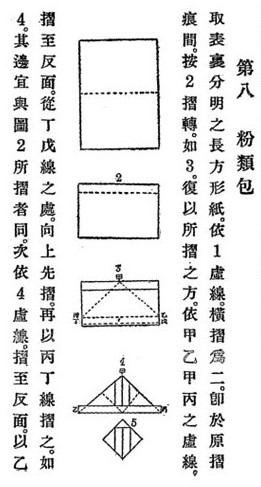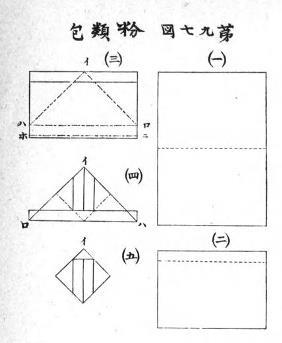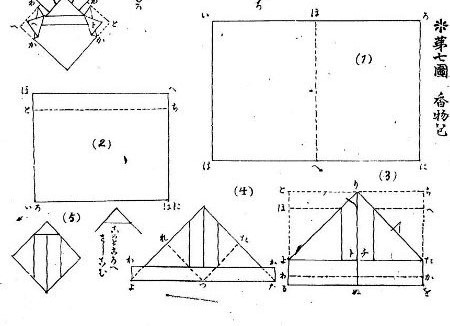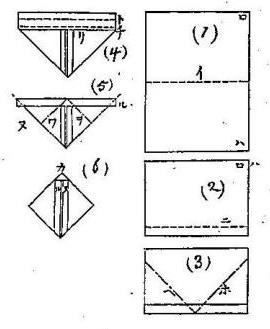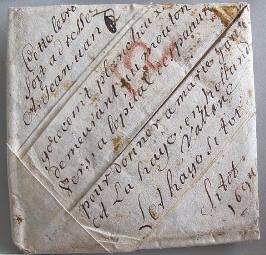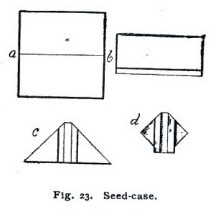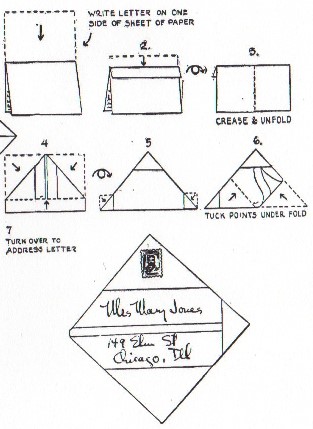| The Public Paperfolding History Project
Last updated 23/1/2024 x |
|||||||
| The Square Letterfold | |||||||
| This
page is being used to collect information about the
history of the origami design known as the Square
Letterfold. Please contact me if you know any of this
information is incorrect or if you have any other
information that should be added. Thank you. ********** In China (and in publications by Chinese authors) 1917 The design appears as 'Powder Packet' in 'Xu Zhe zhi tu shuo' (More Illustrated Paperfolding) by Yongxiang Shi, which was published by the Commercial Press in Shanghai in 1917.
********** In Japan (and publications by Japanese authors) 1903 This design appears in 'Jinjo Kouto Shogaku Shuko Seisakuzu' (Handicrafts for ordinary higher elementary schools) by Hideyoshi Okayama, which was published by Rokushiro Uehara in Tokyo in 1903.
********** The design also appears: 1907 In 'Shukou Tebikigusa : Kokumin Kyoiku Origami Yuihimo' by Ishin Nishigaki, which was published by Meguro Shoten in Nagaoka in 1907, although here it seems to be intended as a package for incense.
********** 1908 As 'Business Card Holder' in 'Origami zusetsu' (Illustrated Origami) by Sano Shozo, which was published in Tokyo in 1908.
********** 1964 'Secrets of Origami', by Robert Harbin, which was published by Oldbourne Book Company in London in 1964, contained diagrams for two designs collected by John M Nordquist and said to have been made by Yoshinaga Ogawa of the Ogasawara School, probably in Kyoto during the Early Meiji Era (1868 - 1912), one of which, called the 'Gift Package' is the same as the Square Letterfold design.
********** In Western Europe and the Americas 1694 The earliest evidence for the existence of this design that I know of comes is an undelivered letter found in the Brienne Postal Archive. The date of 1694 can clearly be seen in the bottom left corner.
According to https://vimeo.com/189352737 ', the author, a man called Leendert Jansen van Muers, is a Dutch soldier writing to his wife back home in The Hague. He tells a sorrowful tale; he has been taken prisoner by the French on 29 July 1693, during the Battle of Neerwinden, one of the most famous encounters between the French army and Dutch-English forces during the Nine Years’ War (1688–1697). Leendert’s son Hans was fighting alongside him, but he doesn’t know what has happened to him, hoping his son has made it safely back home to The Hague. Leendert is begging his wife to send him news. He’s having a hard time in captivity, beautifully capturing the sense of loss and displacement as he writes: “I wished with God’s help that I were with you again, because my heart is aching to be separated from you, in a country and under a people whose language I nor my fathers ever knew.” Forced to enlist in the French army for two years, he is hoping it will soon be peacetime again, allowing him to return home.' ********** 1819 As far as I know formal instructions / diagrams for folding this design first appear in 'Leichte Künsteleien zum Vergnügen und zum Nutzen für Kinder und Richtfinder' by Heinrich Rockstroh, which was published in Berlin by Ludwig Wilhelm Wittich in 1819. (Information from Edwin Corrie: 'Two Early Letterfolds' in British Origami 320 of February 2020)
********* The design also appears: 1836 In another book by Heinrich Rockstroh, 'Belustigungen für die Jugend beiderlei Geschlechts', which was published by Willhem Schuppel in Berlin in 1836. (Information from Edwin Corrie: 'Two Early Letterfolds' in British Origami 320 of February 2020.)
********** 1892 As 'Seed-Case' in 'The Prang Primary Course in Art Education: Part 1: The First Primary Year' by Mary Dana Hicks and Josephine C Locke, which was published by the Prang Educational Company in Boston in 1892.
********** 1961 In 'Vol 2: Issue 1 of 'The Origamian' for Summer 1961 as 'a self sealing letter that can be sent through the mail, dug out of a small battered book now out of print'.
********** 1964 'Secrets of Origami', by Robert Harbin, which was published by Oldbourne Book Company in London in 1964, contained diagrams for two designs collected by John M Nordquist and said to have been made by Yoshinaga Ogawa of the Ogasawara School, probably in Kyoto during the Early Meiji Era (1868 - 1912), one of which, called the 'Gift Package' is essentially the same as the Square Letterfold design.
********** |
|||||||

